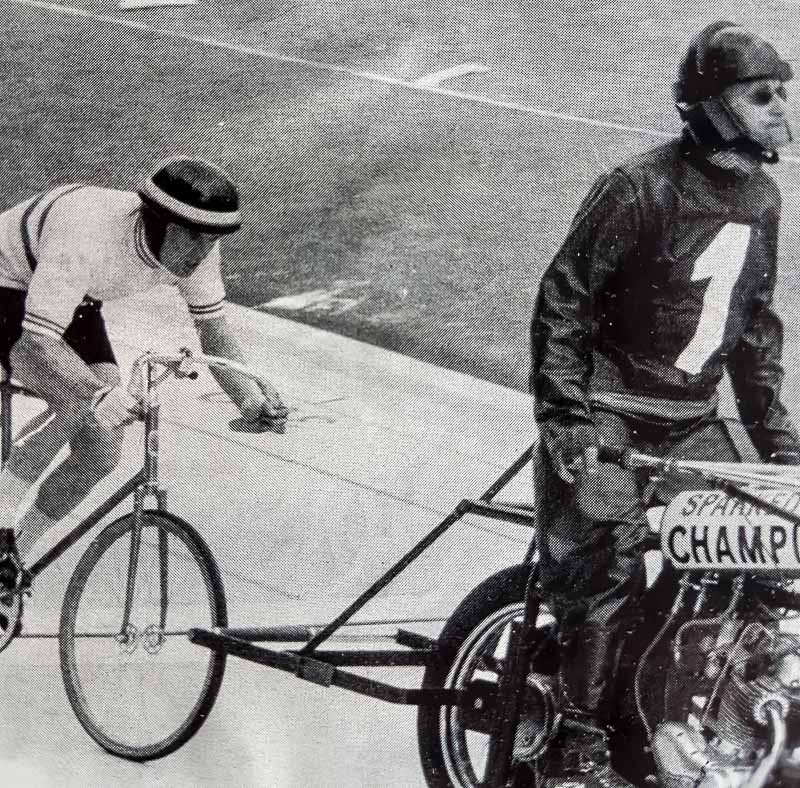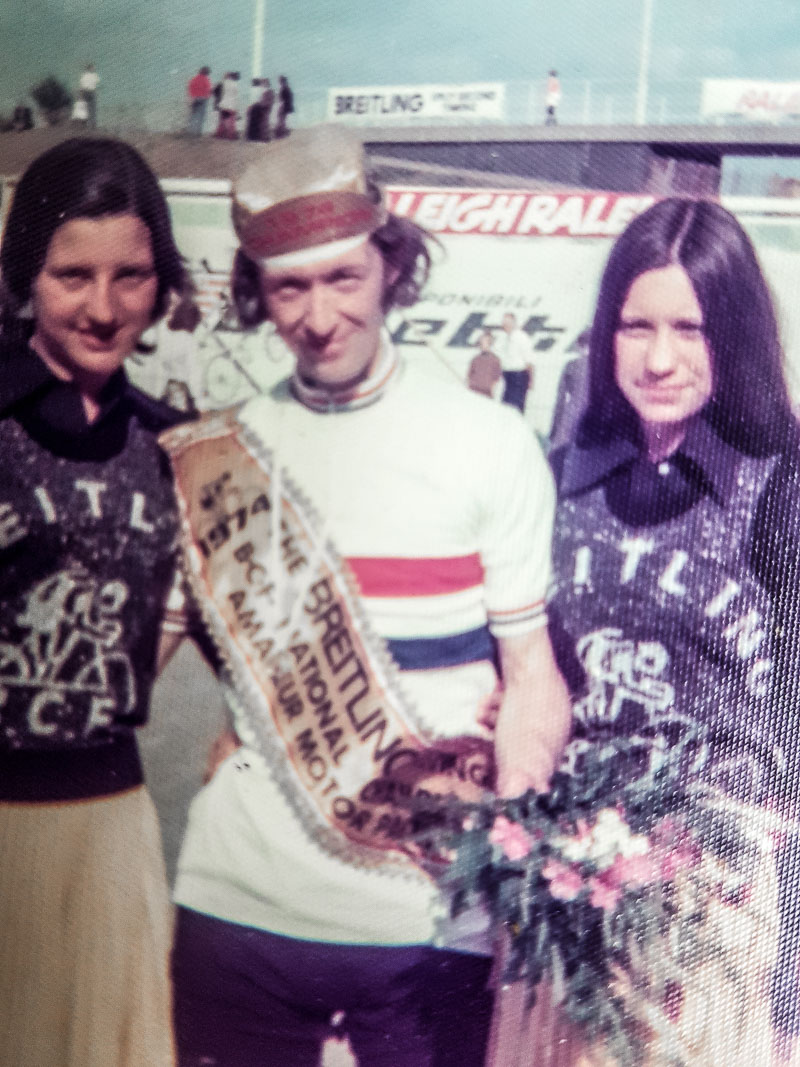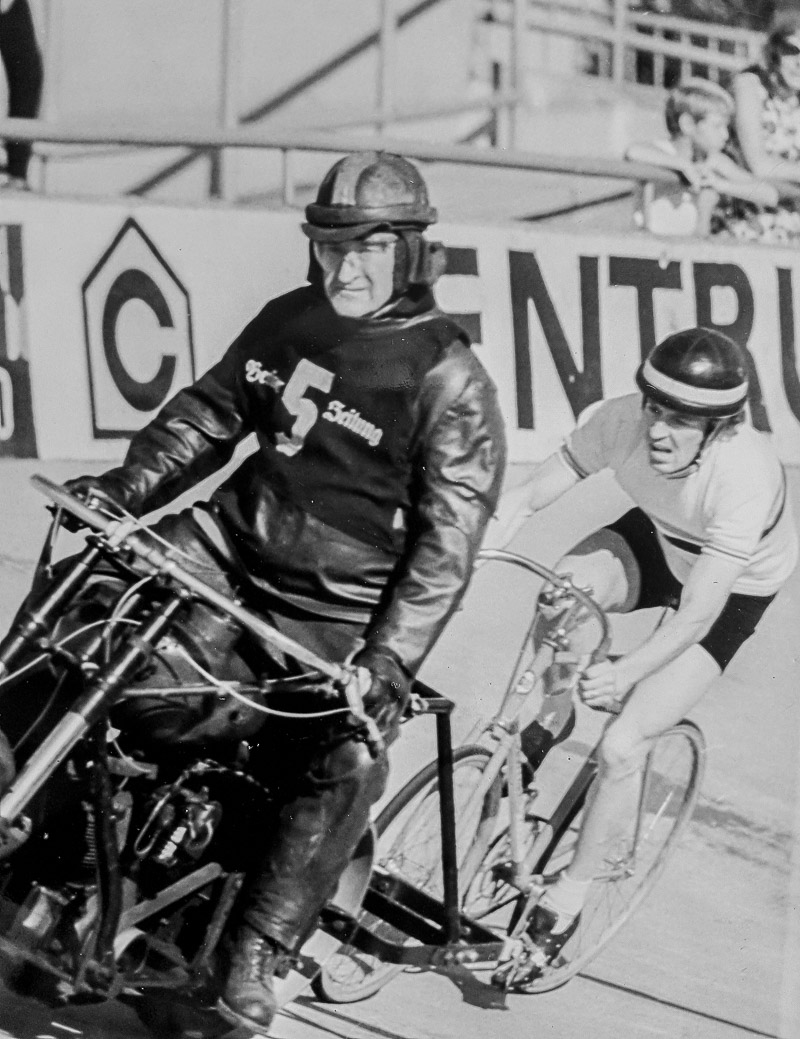Here at VeloVeritas we try to pay our respects to champions who have passed.
Back in 2017 we had the pleasure of interviewing former six time British Motor Paced Champion, Roy Cox who despite his results not actually showing it was one of the best in the world behind the big motors.
His problem, as it was for many, was that the world of the ‘demi-fond’ as the French call it was one which would have been familiar to Machiavelli.
The ‘double bluff swerve’ was the natural order of things but you only knew your pacer had been bought off you when he ripped the legs off you by accelerating too hard or sat you squarely in the ‘wash’ off another bike for lap after legs to kill your legs.
It escaped our notice that we had lost Roy, he passed away in 2019 but our friend and contributor, John Purser decided that Roy’s passing should not go unnoticed and he helped us with a tribute to his friend and club mate.
How did you know Roy, John?
“He was a very active (and very good) track rider living in Birmingham about the time I started racing on the track.
“He was a member (as was I) of the Birmingham Racing Cyclists Club, a ‘super club’ masterminded by Tommy Godwin to chase British Team Pursuit and Madison titles.”
What kind of man was he?
“Small, fitted well in the slipstream of a motorbike or a as a Team Pursuiter, cheerful, always good company.
“I got on well with him, but then I wasn’t a great challenger.
“However, he wasn’t one to create an aura – even if he’d been encouraged to do so.
“He got on well with nearly everyone.”

What did Roy do when he was not sitting behind a Norton?
“Apparently he first had a job as a tyre tester for Dunlop when they made cycle tyres at Fort Dunlop in Birmingham.
“He used to go out for a ride every day with Dave Watkins, a great sprinter at the time.
“The job seems like Nirvana for a racing cyclist.
“However when I knew him he and his father Dennis (another great guy) had a few Transit vans and they did light haulage.
“Later, he had a gym/health club in King Street, Dudley.”
And you rode behind the big motors too, competing against him – what attracted you to it?
“I’d actually seen ‘the big motors’ in action at the World Championships in Rome in 1967 – it was a complete coincidence that I was there on that day.
“Before then, there were occasional references in ‘Cycling Weekly’ magazine to names like Guillermo Timoner and a select group of riders jousting annually for the World Championships.
“A British rider, Joe Bunker had tried to join this elite group in the 50’s and made the Worlds podium in 1954 in Germany.
“In 1970, Britain hosted the road and track World Championships at Leicester and I was a volunteer chauffeur.
“A set of pacing bikes was built (Jawa frames and Triumph engines) and these were left as an asset of the British Cycling Federation at Leicester after the Worlds.
“As a result, a ‘pacing-school’ took root and I became part of it.
“The attraction? It was just ‘different’ from the norm of time trials, road races and most track racing.
“A chance to be noticed, I suppose?”
What was it like for you and Roy to source the highly specialist frames, saddles, chainrings, wheels and tyres?
“As a legacy to 1970, Gerald O’Donovan (the boss at Carlton Cycles) had produced half a dozen bikes for riders to borrow.
“I splashed out and had a proper custom frame built by Stan Lang, formerly at Viking, then on his own at Southern Cross in Telford.
“Roy lent me his frame as a guide, and Stan did he rest – the work of a master of his craft.
“Ron Kitching provided some ‘giant’ TA chain rings and ‘REG’ saddle supports – Stan and I devised a spring loaded version copied from bikes I’d seen at various world championships.
“Adjustable extensions were available from Cinelli.
“Saddles (not everyone felt the need for a special one) could be sourced as specially butchered versions from professional rider, the late Trevor Bull – who was a Commonwealth Games medallist and British Team Pursuit, Professional Madison and Professional Sprint Champion – also in Birmingham, who made the Brooks Professional ‘big rivet’ variant in batches, for Carlton initially.
“Wheels were critical; 27” rear and 24” front with the forks reversed to tuck you in behind the motorbike.
“The wheels were easy enough to build but then came this quite complex system with (normally) Continental tubulars and a unique method of ‘belt and braces’ to secure them to the rim with a rubberised non-woven linen ‘bandage’ (I bought some from Clement, but Continental also supplied them.)
“This was adhered up the tubular wall and then over the rim. It meant that if a tyre punctured it would not detach and get wrapped up in the rim at high speed. They were usually made by the Six Day mechanics ’on demand’.
“My wheels were second hand, from Christian Giscos. The tyres didn’t wear out on smooth tracks.”

What was the 60’s/70’s UK Motor Paced scene like?
“For the 1960s I can’t say, I wasn’t there but it was on a lower level, simply because there were so few participants.
“The watershed was after 1970 and the legacy of the Leicester World Championships. The pacing motorbikes (and leathers which the pacers wore) were there, as were some suitable pace bikes provided by Gerald O’ Donovan of Carlton (and subsequently of TI Raleigh and Raleigh SBDU).
“Benny Foster (who had organised the Worlds) located a Frenchman, living in Britain, who had been a medallist in the Worlds demi-fond Championships in the ‘60s. This was Christian Giscos, a wonderful character who had come to England with an English bride.
“He made a living as a market trader selling the finest bone china tea sets to the unsuspecting populations of several southern towns like Salisbury.
“He was an inspiration to many of us, and tackled the mountain to climb, training both riders and pacemakers. Eventually, he became Alan Johnson’s pacer, seriously challenging the Roy Cox /Jack Collins combo put together by Ron Webb. John Hall had his father-in-law, Les Robinson.
“But Christian had also been really helpful in guiding the other trainee pacers – Clive Murden (who went on to ride with Rik Notley) and Ray Gee were pacers, both of whom I used and benefitted from the camaraderie of the group.
“The pacing school made the discipline a draw for the big track meetings that were put on at Leicester, events like the ‘Autumn Gold’.
“Simultaneously, I tried to ‘take the motors out of Leicester’ and we went as a group to Manchester, to the Fallowfield Stadium which was run by Norman Grattage, and to Halesowen.
“Den Cox used his Transit to bring the bikes over and a generous supporter allowed him to fill up at his garage free of charge – it was that grass roots level of support we had.
“A bit like a prime of a joint of meat in a Belgian kermis race (if the riders sprinted in front for it in front of the shop). The BCF actually spent quite a lot of money on the group; I remember Bruno Walrave coming over for a weekend of ‘tuition’ and another German pacer, who was equally helpful.
“By that time, I’d become friendly with Dieter Kemper who eventually became World Champion at Motor Pacing in 1976 and he’d explained the ins and outs of it, all similar to those in the Six Days that were so popular in Europe back then.
“I was also friendly with Norman Hill, nominally a sprinter who competed behind the motors in the Worlds in 1971 and George Halls, who had moved to The Netherlands and rode with distinction on indoor tracks behind the big motors.
“My own success was minor, but the confidence injected by Roy, Dieter, Norman and probably most of all by George stood me in good stead back then and as a mantra in later life; ‘if you really want it, you can have it.’”
Tell us about Roy’s connection with the late Ron Webb, Australian pace follower then race promoter and track builder.
“I must admit that I thought Ron had a Svengali influence on Roy.
“Roy was anything but stupid but seemed to be over-dominated by Ron’s ambitions. Roy was introduced to the East German scene by Ron and enjoyed a period of success… Roy didn’t have a deprived life in Birmingham – far from it.
“He commanded respect from a lot of his fellow competitors, he was a big fish in the pond here, but in East Germany, he was a bit more of ‘a star;’ Scharndorf, his pacer over there took him up to that level in Berlin, Leipzig and beyond.
“Remember though, racing behind the big motors wasn’t a full time job for anyone, was more of a lucrative hobby, perhaps?”

Did Roy relate any tales of his time racing in East Germany?
“A bit, but I came later. A lot of English riders ‘went to the Continent’ in the 50s, 60s, 70s and 80s. Local families recognised their ambition, took them under their wing and helped them become established. A few made it to the top rank.
“Roy would have been a novelty in East Germany at the time – but it was very much a regime where you did as you were told. Roy did.
“He arrived, was accommodated by the East German Ministry of Sport, put on a great show for the masses who worked in the factories by day and could be entertained by night at the bike races.
“Roy once told me that he had contemplated living full time there. Luckily, he had just married Paula and that was the end to it. Roy was a great friend back then, and I doubt he would have enjoyed being told what to do all the time. I suspect he enjoyed being a big fish for a while, as he was during the ‘70s, in England.
“He didn’t get sent to the Worlds, though – the BCF never had any funds.
“The eventual UCI, ‘rider and pacer of the same nationality’ ruling would have been against him, but there were some epic battles around Leicester and elsewhere that we all enjoyed.
“Years later, I helped bring riders and pacers over to Herne Hill for an great Good Friday meeting race.
“I enjoyed that, too!”
Rest in Peace, Roy Cox, champion pace follower.
With thanks to John Purser.



